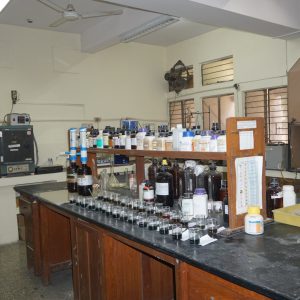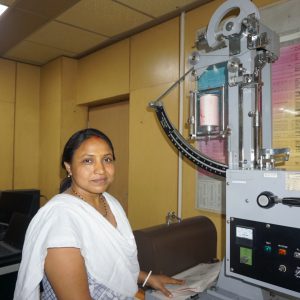About Us









CSB-CSTRI is the only research institute in the country dedicated to the Research & Developmental activities related to silk technology. CSB-CSTRI was established in the year 1983 by the Central Silk Board, Ministry of Textiles, Govt. of India. Till then, silk technology had only the status of a division in the sericultural research institutes in the country. Appreciating the need for a greater thrust on the demand side of the silk industry, the establishment of CSB-CSTRI was the first step in the right direction. Today, CSB-CSTRI is recognised as one of the Textile Research Associations in the country by the Government of India.
The Mandate:
- Quality improvement
- Productivity improvement
- Services to the industry
- Enterprise development
- Market information dissemination.
Objectives:
- To improve the quality of silk products viz. raw silk, spun silk and silk fabrics.
- To develop and introduce process and quality control measures in the production units.
- To improve productivity through process and machinery standardization.
- To upgrade the machinery used in reeling, spinning, weaving and wet processing.
- To enhance the utilization of bi-products for better returns.
- To provide training, encompassing skill, technology and management.
- To provide technical and consultancy services to the industry.
- To provide services for testing of cocoons, fibre, yarn, fabric, dyes, chemicals and water as per national and international standards.
- To plant the technology through various schemes.
- To disseminate research findings through various field interaction programmes.
- To adopt production units for transfer of technology.
- To provide technical guidance/assistance for setting up new enterprise.
- To provide on-line information regarding products, processes, technology, machinery, domestic and export markets.
The Industry:
The silk industry is unique for more than one reason. Silk industry is based on agricultural output viz., cocoons, which are highly variable in nature, it is highly labour intensive, cottage based, decentralized and highly traditional, associated with high value and low volume. The approaches applicable to other textile sectors are not just applicable to the silk industry and perhaps this explains why silk as a Textile fibre has not been researched much by the Textile Research Institutes established in the country and thus the need for specialized research institute exclusively for silk. The nature of the silk industry is quite involved and complex. It encompasses various streams viz., silk reeling, silk preparatory and weaving, silk knitting, silk wet processing comprising degumming, dyeing, printing and finishing, besides the ancillary support mechanisms of market research, exports, garment manufacture & machinery manufacturing.
The research focus at CSB-CSTRI covers all the four commercially known varieties of silks viz., mulberry, tasar, muga and eri. lnspite of the commonalities, non-mulberry silks differ from the mulberry, thereby necessitating separate interventions adoptable under the techno-economic and social conditions prevailing in the sector. The main institute is ideally located in Bangalore, the silk capital of the country. Over a period of time, CSB-CSTRI has established 14 sub units in different important silk clusters right across the country, which serve as conduits for transfer of technology. There are three broad categories of the sub units with specific mandates to focus. They are (1)Demonstration cum Technical Service Centres (DCTSC) (2)Silk Conditioning & Testing Houses (SCTH) (3) Textile Testing laboratories (TTL).
The Main Institute:
The Main Institute is structured in such a way that the functional areas are given due emphasis. Research on all aspects of yarn production, fabric formation, designing, wet processing, training, extension and market information dissemination are addressed in the respective divisions. The research and technical co-ordination of the various divisions of the Main Institute, sub-units of CSB-CSTRI and the state government departments as well, is delegated to the research and Technical Coordination Cell. Sericulture being a state subject, and since CSB has the responsibility for the entire country, it calls for a lot of coordination effort to ensure that we compliment each others activities for the development of the industry. The Research and Development, training and extension activities of the institute are ably assisted by the supporting divisions of, administration, stores and accounts.
The Sub Units:
The DCTSCs have the mandate of providing technical services to the silk production clusters (reeling as well as weaving) in their command area. They cover wide ranging aspects of technology dissemination through demonstrations, interactions and training, problem solving, improvement in work practices, besides providing other support mechanisms for quality improvement and productivity improvement. They have infrastructure for reeling and minimum quality testing. The DCTSCs hove a small team of technically qualified personnel with adequate experience. They have been able to create a positive impact for the cause of the development of the silk industry in the region. The success stories speak volumes about the difference the DCTSCs have been able to make in the region.
The SCTHs have the exclusive mandate of inculcating quality awareness among the manufacturers and buyers, besides ushering in the discipline of quality based pricing in raw silk and twisted silk transactions. The progress of any manufacturing sector largely depends on the thrust that is provided on quality. It was an uphill task, given the status of a sellers market, demand exceeding the supply and quality taking a back seat. There was a stage in the beginning, wherein persistent efforts towards educating the people on the importance of quality, did not inspire them to get their samples tested inspite of the fact that testing services were provided free of charge. Now it is a matter of pride, the perseverance of our SCTHs’ has paid dividends. No efforts are spared to meet the growing demand for testing and now it is despite the fact that the testing services are charged.
The environmental and ecological considerations have assumed an increasing significance for producers, traders and consumers. There has been an accelerated evolution of environmental and ecological legislation in many countries, especially the European Union. Though it is primarily intended to protect the environment in the developed countries and their ecological criteria for textiles, it will continue to have an impact on products traded internationally. The European Union are ensuring the success of eco labeling scheme. In the light of the above, it became imperative for the Government of India to create adequate infrastructure for testing the ecological parameters of textiles to ensure that the export trade is safe guarded. CSB-CSTRI has thus setup TTL at four centers including one at the main institute to cater to the needs of physical, chemical and eco parameter testing of silk textiles. The timely action from the Ministry of Textiles, Govt. of India has in fact been a boon to the textile industry in general and silk industry in particular.
